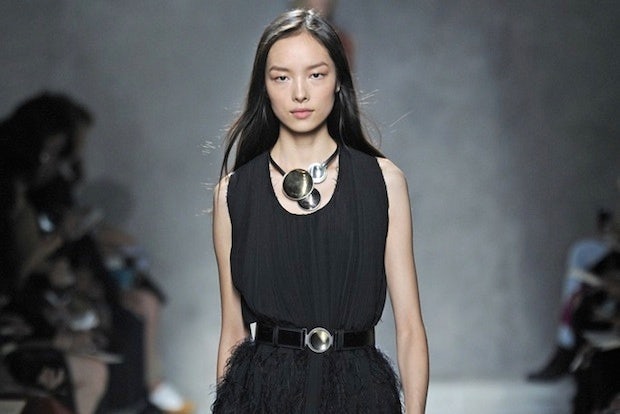
Chinese model Fei Fei Sun on the Bottega Veneta S/S 2014 runway. (WWD)
Recent data strongly suggests that China’s luxury market is still in slowdown mode, but while some companies are seeing a strong slump, a clear set of winners is making it through 2013 with solid sales.
Now in the fourth quarter, there’s no doubt that year-end growth rates in China’s luxury industry aren’t going to rebound to anything close to pre-slowdown numbers. A study released last week by Bain & Company predicted that 2013 luxury sales in China would grow by only 2.5 percent to 15.3 billion euros. There’s speculation that the slowdown may be long-term, as well: a recent luxury CEO survey by Departures and Ledbury found that executives are more confident about the North American luxury market than about East Asia as a driver of growth over the next five years, and former Burberry CEO Angela Ahrendts said on-record last month that slowing luxury growth rates are “the new normal” for the industry.
When taking a look at individual brands, however, the slowdown rate is highly uneven, continuing a trend that has been going on all year. When it comes to fashion, “mega-labels” were not able to rebound from a first-half sales slump as they had hoped: Louis Vuitton experienced 5 percent growth, a number in line with the first half of the year, while Gucci saw “low single-digit” decline in China. It is likely that a main reason for the lagging growth has been Chinese consumers’ growing sophistication and shifting preferences away from logo-heavy designs, as these brands have made efforts to increase their number of logo-free products and worked to avoid overexposure.
This growing sophistication is emphasized in the fact that smaller niche labels as well as “masstige” brands have fared significantly better in both the third quarter and the previous first half of the year. While Kering did not earn much revenue from Gucci, its smaller brands posted double-digit Greater China growth for the third quarter, with Bottega Veneta bringing in 30 percent and Stella McCartney, Alexander McQueen, Balenciaga, and others collectively averaging 14 percent growth. Meanwhile, the more affordable “masstige” category has also seen success, as Coach saw a 35 percent jump in sales for the third quarter.
These substantial growth numbers are taking place because Chinese consumers are buying these products for themselves or for family and friends—not for corrupt “gifting” purposes. As a continued stream of new anti-corruption efforts demonstrates, Xi Jinping’s anti-graft crackdown is also still in high gear, and hitting many luxury sectors most associated with corruption or ostentatious displays of wealth that have been getting officials in trouble. For example, Swiss watch exports to China continue to decline, high-end liquor sales are still slumping, flashy car companies such as Ferrari and Lamborghini are seeing lower sales, and banquet foods such as shark-fin soup are in trouble.
This downturn contrasts sharply with the aforementioned growth of successful fashion brands, as well as that of other consumer-oriented sectors such as beauty and mass luxury cars. Although LVMH was disappointed in its Louis Vuitton numbers, it said growth was strong in China for BeneFit cosmetics and Sephora sales. Meanwhile, China’s wealthy apparently aren’t worried about being too ostentatious if they drive an Audi or a BMW, as Volkswagen’s China sales rose 18 percent from the beginning of the year until September, and BMW’s grew by 20.8 percent.
The bottom line for the luxury sector is that the numbers show that even if China’s slowdown is long-term, brands with the right marketing strategies and an understanding of Chinese luxury consumers can still experience solid growth. According to the recent Departures/Ledbury survey, the Chinese growth rate was the third-highest factor in cause for optimism about the global luxury market. Additionally, luxury CEOs recognize that China’s expected GDP growth rate of 7.5 percent is still comparably high, and previously skyrocketing rates merely reflected unsustainable numbers.
In addition, companies worried about China growth should take a look at the global picture: Chinese customers may not be buying as much luxury at home, but they’re certainly spending it abroad as the world’s largest-spending bloc of tourists. As a result, brands must focus on the Chinese consumer on an international level in order to truly cash in on the market's high long-term growth potential.